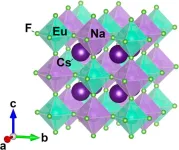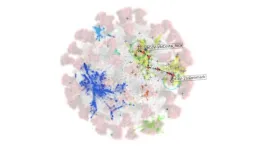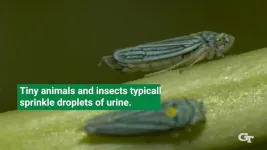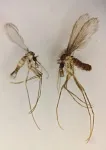(Press-News.org) In the quest to develop quantum computers and networks, there are many components that are fundamentally different than those used today. Like a modern computer, each of these components has different constraints. However, it is currently unclear what materials can be used to construct those components for the transmission and storage of quantum information.
In new research published in the Journal of the American Chemical Society, University of Illinois Urbana Champaign materials science & engineering professor Daniel Shoemaker and graduate student Zachary Riedel used density functional theory (DFT) calculations to identify possible europium (Eu) compounds to serve as a new quantum memory platform. They also synthesized one of the predicted compounds, a brand new, air stable material that is a strong candidate for use in quantum memory, a system for storing quantum states of photons or other entangled particles without destroying the information held by that particle.
“The problem that we are trying to tackle here is finding a material that can store that quantum information for a long time. One way to do this is to use ions of rare earth metals,” says Shoemaker.
Found at the very bottom of the periodic table, rare earth elements, such as europium, have shown promise for use in quantum information devices due to their unique atomic structures. Specifically, rare earth ions have many electrons densely clustered close to the nucleus of the atom. The excitation of these electrons, from the resting state, can “live” for a long time—seconds or possibly even hours, an eternity in the world of computing. Such long-lived states are crucial to avoid the loss of quantum information and position rare earth ions as strong candidates for qubits, the fundamental units of quantum information.
“Normally in materials engineering, you can go to a database and find what known material should work for a particular application,” Shoemaker explains. “For example, people have worked for over 200 years to find proper lightweight, high strength materials for different vehicles. But in quantum information, we have only been working at this for a decade or two, so the population of materials is actually very small, and you quickly find yourself in unknown chemical territory.”
Shoemaker and Riedel imposed a few rules in their search of possible new materials. First, they wanted to use the ionic configuration Eu3+ (as opposed to the other possible configuration, Eu2+) because it operates at the right optical wavelength. To be “written” optically, the materials should be transparent. Second, they wanted a material made of other elements that have only one stable isotope. Elements with more than one isotope yield a mixture of different nuclear masses that vibrate at slightly different frequencies, scrambling the information being stored. Third, they wanted a large separation between individual europium ions to limit unintended interactions. Without separation, the large clouds of europium electrons would act like a canopy of leaves in a forest, rather than well-spaced-out trees in a suburban neighborhood, where the rustling of leaves from one tree would gently interact with leaves from another.
With those rules in place, Riedel composed a DFT computational screening to predict which materials could form. Following this screening, Riedel was able to identify new Eu compound candidates, and further, he was able to synthesize the top suggestion from the list, the double perovskite halide Cs2NaEuF6. This new compound is air stable, which means it can be integrated with other components, a critical property in scalable quantum computing. DFT calculations also predicted several other possible compounds that have yet to be synthesized.
“We have shown that there are a lot of unknown materials left to be made that are good candidates for quantum information storage,” Shoemaker says. “And we have shown that we can make them efficiently and predict which ones are going to be stable.”
*
Daniel Shoemaker is also an affiliate of the Materials Research Laboratory (MRL) and the Illinois Quantum Information Science and Technology Center (IQUIST) at UIUC.
Zachary Riedel is currently a postdoctoral researcher at Los Alamos National Laboratory.
This research was supported by the U.S. Department of Energy, Office of Science, National Quantum Information Science Research Center Q-NEXT. The National Science Foundation through the University of Illinois Materials Research Science and Engineering Center supported the use of facilities and instrumentation.
END
Design rules and synthesis of quantum memory candidates
2024-03-11
ELSE PRESS RELEASES FROM THIS DATE:
BIDMC-led trial leads to FDA approval of coronary drug-coated balloons
2024-03-11
BOSTON – In the largest randomized clinical trial and first of its kind to date in the United States, a team led by investigators at Beth Israel Deaconess Medical Center (BIDMC) assessed the efficacy and safety of using a drug-coated balloon in patients undergoing coronary angioplasty. In an original investigation presented at the Cardiology Research Technology conference in Washington, D.C. and published simultaneously in JAMA, the team reports that patients treated with a balloon coated with paclitaxel, a drug to prevent restenosis, experienced lower rates of failure compared with patients treated with an uncoated balloon.
The findings of the trial—which ...
This protein pic could help develop new cancer treatments
2024-03-11
Some cancerous tumors hijack proteins that act as “brakes” on our immune system and use them to form a sort of shield against immune recognition. Immunotherapy treatments have been created that turn off these “brakes” and allow our body to attack foreign-looking cancer cells. To further advance such treatments, researchers at Stanford University and New York University have published a new structure of one of these brake proteins, LAG-3. Their work contains key details of the molecule’s structure, as well as information about how the LAG-3 protein functions.
Although over a dozen immunotherapies targeting LAG-3 are in development, and one is already FDA approved, ...
Mathematicians use AI to identify emerging COVID-19 variants
2024-03-11
Scientists at The Universities of Manchester and Oxford have developed an AI framework that can identify and track new and concerning COVID-19 variants and could help with other infections in the future.
The framework combines dimension reduction techniques and a new explainable clustering algorithm called CLASSIX, developed by mathematicians at The University of Manchester. This enables the quick identification of groups of viral genomes that might present a risk in the future from huge volumes of data.
The study, presented this week ...
Cicadas’ unique urination unlocks new understanding of fluid dynamics
2024-03-11
Cicadas are the soundtrack of summer, but their pee is more special than their music. Rather than sprinkling droplets, they emit jets of urine from their small frames. For years, Georgia Tech researchers have wanted to understand the cicada’s unique urination.
Saad Bhamla, an assistant professor in the School of Chemical and Biochemical Engineering, and his research group hoped for an opportunity to study a cicada’s fluid excretion. However, while cicadas are easily heard, they hide in trees, making them hard to observe. As such, seeing a cicada pee is an event. Bhamla’s team had only watched the process on YouTube.
Then, ...
New research sets trap for potentially deadly sandfly
2024-03-11
Scientists have discovered the specific enzyme that a species of sandfly uses to produce a pheromone attractant, which could lead to the creation of targeted traps to control them and reduce the spread of the potentially fatal disease, Leishmaniasis.
The team from the University of Nottingham’s School of Chemistry analysed the genome of the Lutzomyia longipalpis, a species of sandfly native to Brazil and South America that can spread a disease called Leishmaniasis.
The study identified the enzyme, called a Terpene Synthase that is responsible ...
A new sensor detects harmful “forever chemicals” in drinking water
2024-03-11
CAMBRIDGE, MA -- MIT chemists have designed a sensor that detects tiny quantities of perfluoroalkyl and polyfluoroalkyl substances (PFAS) — chemicals found in food packaging, nonstick cookware, and many other consumer products.
These compounds, also known as “forever chemicals” because they do not break down naturally, have been linked to a variety of harmful health effects, including cancer, reproductive problems, and disruption of the immune and endocrine systems.
Using the new sensor technology, the researchers showed that they could detect PFAS levels as low as 200 parts per trillion in a water sample. The device they designed could offer a way ...
Robotic interface masters a soft touch
2024-03-11
The perception of softness can be taken for granted, but it plays a crucial role in many actions and interactions – from judging the ripeness of an avocado to conducting a medical exam, or holding the hand of a loved one. But understanding and reproducing softness perception is challenging, because it involves so many sensory and cognitive processes.
Robotics researchers have tried to address this challenge with haptic devices, but previous attempts have not distinguished between two primary elements of softness perception: cutaneous cues (sensory feedback ...
Tuberculosis bacteria also present in 90% of those with symptoms, who are not diagnosed with TB
2024-03-11
Mycobacterium tuberculosis (Mtb), the bacteria that causes a tuberculosis infection, is present in exhaled breath of 90% of those presenting with suspected tuberculosis. This includes those who were negative on conventional sputum testing and not diagnosed with TB. This raises the possibility that those who have tested negative may be unknowingly transmitting the infection. Researchers from the University of Cape Town and Amsterdam UMC analysed results from over 100 patients who presented themselves to clinics in South Africa. These findings are published today in PNAS.
“If ...
U of M-led study reveals shared blueprint in brain development across different functional areas
2024-03-11
In a new study published in Proceedings of the National Academy of Sciences (PNAS), researchers from the University of Minnesota Medical School investigated brain development to understand how different areas of the brain become specialized in handling information such as vision, sound, touch and planning.
The study found that different areas of the brain start with a similar organization rather than already being specialized in early development. This suggests that the brain might use a single shared blueprint to guide early development.
“Throughout life, the brain continually builds on the foundations set ...
Researchers solve crucial cold-induced sweetening problem in potato production
2024-03-11
Researchers have discovered a game changer for the potato industry.
According to a new study published in a leading international society journal published by the American Society of Plant Biologists, a small genetic element is the cause of a major production problem in potatoes.
“Our manuscript reveals the mystery of “cold-induced sweetening” (CIS), the most troublesome and expensive problem for the potato processing industry,” explained Jiming Jiang, Corresponding Author of “Molecular dissection of an intronic enhancer governing cold-induced expression ...





